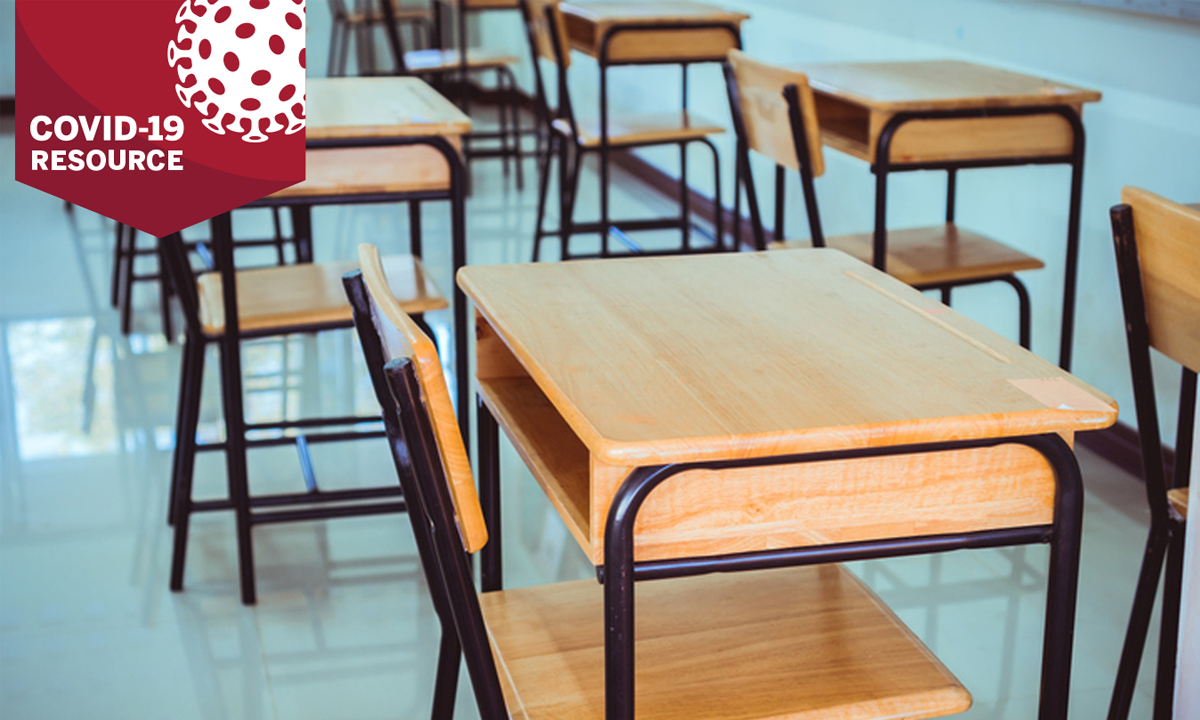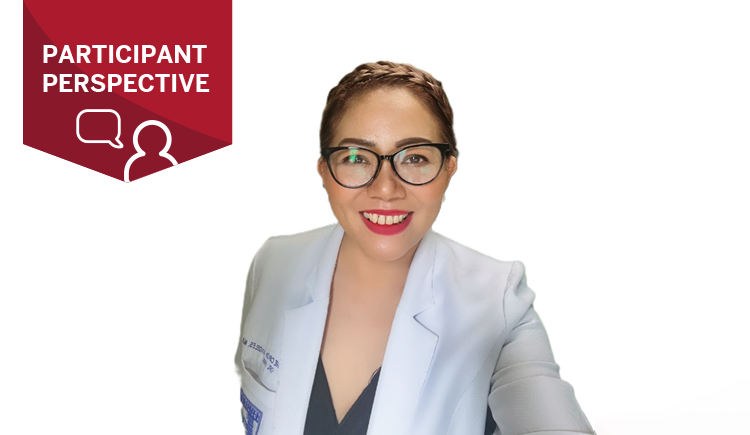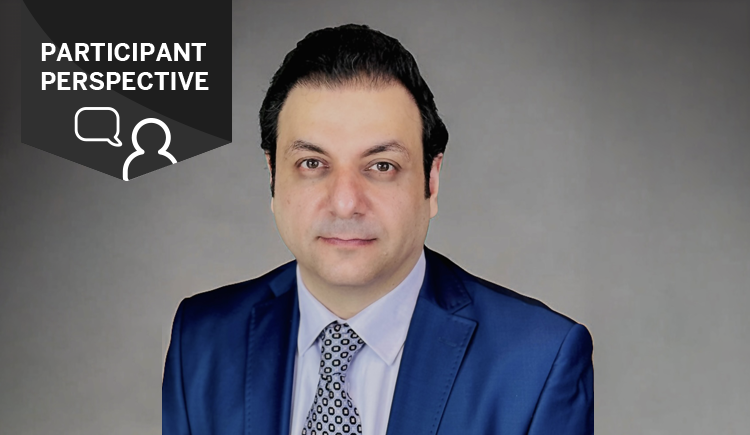
Information regarding COVID-19 has rapidly evolved. The content in this article provides a historical snapshot of events surrounding the date of posting.
In the midst of the COVID-19 pandemic, schools across the United States are beginning to reopen for the 2020-2021 school year. As part of our ongoing Clinical Management Through COVID-19 webinar series, Melissa Bartick, MD spoke with expert panelists, Joseph Gardner Allen, D.Sc., MPH and Jeremy S. Faust, MD, MS, MA about their perspectives on how schools can effectively plan to reopen. This interview was adapted for the written format.
First off, what is the evidence that children are likely to transmit COVID-19? How likely are children to get sick?
Dr. Faust: I think it would be helpful to first review overall COVID pediatrics statistics, as determining the number of COVID cases in both young and school age children depends on the detection strategy. We hear that even fewer than 5% of COVID cases are in the pediatric population, but that might be a matter of who we're testing.
For example, in Massachusetts, we group children in ages 0 to 19. The positivity rate is currently 1/2 to 1/3 of the infection rate, which is not nothing, but it's a lot less than the adult population. Things get a little more reassuring, thankfully, when you look at hospitalizations and deaths.
Hospitalization rates among kids, both as numbers and also per population, per capita, are very low. There are very few pediatric hospitalizations, but enough. In certain areas like New York, we've seen inflammatory conditions present. The deaths are very small.
One interesting finding worth repeating, is that most kids have a much milder disease. It seems like the children have sooner presentation of symptoms, so there's less of a transmission window. We do know that for a small fraction of kids that do get sick, that they get very sick. We know this because once children are hospitalized, their need for oxygen, their need for the intensive care unit (ICU) is a bit higher.
Dr. Allen: Recently, there are three important questions surrounding this topic: Are children less likely to get COVID-19 than adults? It seems to be yes. Are they less likely to suffer from the severe consequences like adults? Largely speaking, thankfully, the answer is yes. The third outstanding question I’m trying to understand is, are children more or less likely to transmit COVID than adults? At this point, we have compelling evidence that the 0- to 9-year-olds are less likely to transmit the virus.
It gets a bit muddier for the 10- to 19-year-olds. Inside the United States, we don't have much evidence on transmissibility with schools open. We're basing a lot on what is happening overseas.
On the subject of contagion, there was one South Korean study that showed kids 10 and over are as infectious as adults. I'm wondering the implications of that for schools. Does that mean that we should be concerned about schools being open for older children?
Dr. Allen: I've been looking at that study pretty carefully. It's a really important study. Unfortunately, I think it generates some headlines that don't quite capture the data. The data presented in that study is split into two groups: in-home transmission and transmission outside of the home. Many news headlines focused on half the data set. That data set could have generated a headline that said, ‘0- to 9-year-old kids are two-to-three times less likely to transmit than adults.’ That's an important finding. The headline instead was, ‘10- to-19-year-olds transmit COVID the same as adults.’
However, there was something incongruent in the data when examined carefully. The 10- to 19-year-olds in that data set didn't look like the 0- to 9-year-olds, nor did they look like the 20- to 29-year-olds. They were really an outlier.
It makes a lot more sense, looking at the other half of the same table. The 0- to 9-year-olds are [transmitting the disease] less than adults. For me, it was a giant caution flag looking at the data set. Something doesn't quite make sense. Because of the methodology of the study, we've had difficulty determining who was the index case. Certainly, the South Korea study does not support the conclusion that 10- to 19-year-olds transmit COVID the same as adults in totality. There's lots of methodological concerns about that study, and the data are incongruent, even within this study. It's enough to say, let's ‘pump the brakes on that’ before we draw a major conclusion on the transmission of 10- to 19-year-olds.
Looking at the totality of evidence in this one study, plus everything else we know, leads to my opinion, at this point, that the younger ages appear to transmit COVID less.
How do we think about this risk of opening schools? We know that school is important for children. But how do we think about the risk? The risk is real. It's not realistic to think there will not be any serious cases of COVID among children—and certainly among adults— as a result.
Dr. Allen: When you multiply these relatively lower risks against many people, there will be cases. There's no such thing as zero risk in anything we do, and certainly not during a pandemic.
We need to assess exposure and risk. We often tend to examine the in-classroom risk and isolate that from the broader conversation of risk. We all know the risk of not being in school in person, right? Virtual dropouts—in Boston, 10,000 high school kids didn't login during May. We've seen statistics that for May in Philadelphia, only 1/2 of the elementary school kids check in on any given day.
Millions of kids rely on schools for food. We know children are more sedentary when they're home. There's no socialization. UNICEF says they're at greater risk for abuse, exploitation, violence and neglect.
That's the bigger question here, right? So ideally, we need to prioritize getting kids back in school. As a country, we have opted for reopening other aspects of the economy ahead of prioritizing opening schools. This is the bigger conversation of risk.
One topic often ignored are healthy building strategies, such as higher ventilation rates, better filtration, portable air cleaners and engineering controls in schools. If we do these strategies well, we know we can drive down the in-classroom risk and weigh that against risk of keeping kids out of school.
Of course, another condition precedent is controlling community spread, which needs to happen first and foremost before schools can reopen.
Dr. Faust: That's exactly right. The headlines are going to call out cases in schools. These front-page headlines are coming every week for the rest of the year, regardless of how prevalent the disease is, because there's enough cases that it'll be there. The presence of those headlines won't actually give us any information. They'll make everyone panic.
What I foresee happening is a triage situation. There will be places that aren't going to open because the risk is considered to be too high or the public has no appetite for opening. Then there will be [school districts] who are going to try open. I think it's going to be ‘the law of the jungle.’ It's going to reflect people's perception and will depend on community spread, not necessarily the number of tests the schools are completing.
What should the criteria be for opening schools? What do you think about the states that are opening schools with widespread virus and high-test positivity rates? What criteria should we be using?
Dr. Allen: There are two conditions present. One is the ‘when to open,’ and that is based on community spread. The second one is, ‘what needs to be done’ and ‘what is happening in the school.’
In terms of community spread, a resource that I helped with is Key Metrics for COVID Suppression, which was led by Danielle Allen at the Safra Center for Ethics, Harvard Global Health Institute. In it are possible metrics to track, different risk levels and possible outcomes.
For example, the main metric is daily new cases per 100,000 people. It's a probability question. If you're over 25 daily new cases per 100,000 people—we call that the red—that should mandate everybody stay home.
For example, if you tie this metric to recent outbreaks like the one in Georgia, it makes sense. At the time they had an outbreak in schools, they had 37 new cases per 100,000 people. They are well over the metric we've outlined. It's kind of predictable, if you have that level of community spread. If you read the details of the outbreak, they weren't following recommended guidelines.
I read their school plan. It talks about disinfection and masks. But according to the teachers, they weren't wearing their masks. Their plan doesn't mention ventilation at all.
If there is a high level of community spread, and schools are reopening at that point, it becomes a numbers game. Someone is likely to be sick in that group. In a school room without ventilation and without masks, it is probable that there will be cases within the school.
Unfortunately, the populations most at risk for getting the virus also tend to be the least equipped to do remote learning at home. We need some creative solutions to help those families. This virus has exposed many different issues about equity—in terms of health care access, but now equity in education and educational access. How can we address this issue?
Dr. Faust: This virus is exposing the systemic weaknesses across our society. That extends to schools, of course. If you look at the data on schools and school infrastructure, on ventilation alone, 90% of schools don't meet the minimum standard. That's not even a standard that's set for infection control. This disproportionately affects low-income and communities of color.
In these communities, there are teachers who haven’t seen or heard from students since March. There are students unaccounted for, who have parents who are essential workers. The biggest issue here is, why have we not prioritized getting kids back in school?
When we closed schools in March, it should have been a national priority to get kids back to school. Instead, we're doing this piecemeal state-by-state approach. Kids are being left behind. These devastating costs of school closures will be the next 10 years of public health research. It's hard to hear as a public health person how we're not prioritizing reopening schools.
How do we address these issues now? Are supervised online learning centers viable? Or are there other solutions?
Dr. Allen: I have two ideas. One is prioritizing safely reopening schools. Then we can think about other sectors of the economy. Two, we're spending trillions of stimulus dollars. We've bailed out many industries. It costs about a billion dollars to get ventilation in every classroom. That sounds like a lot of money, but it's a fraction of total spending.
We step back our reopening phases to prioritize kids getting back to school, and we make improvements. Fixing the air handling systems are going to take time. But deploying masks, portable air cleaners and stepping back our re-opening phases could get us there quickly.
So, we close bars, restaurants, nightclubs and casinos. We work on schools and put in portable air cleaners and mandate masks. Then hopefully, this brings an equitable change.
Dr. Faust: I think we're asking the wrong questions in many ways. For example, my question wouldn't be, what date should we reopen schools? My question should be, how long do you want school to stay in session? If the goal is to keep school open for two months at a time, shutdown and then open for another two months, let's discuss how long we can keep schools open.
Secondly, we can't know where to spend our resources if we don't have good data. In the beginning, we were totally ill-equipped for this crisis in this country. It is atrocious that the federal government had to outsource tracking to the media and schools of public health.
Right now, we're not getting good data. I guarantee you the people who already get discriminated against are going to be underrepresented in our data. Then there will be less resources. Even if resources are relatively affordable, they are not going to be diverted to the right areas.
We need to insist on public data that is reliable and easy to access to guide our response. If we don't, then the haves and the have-nots are going to get worse. That's where this virus really does its worst.


